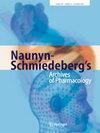在大鼠 C6 胶质瘤模型中证实了贝伐珠单抗鼻内溶胶凝胶制剂从鼻腔向大脑给药的前景。
摘要
胶质母细胞瘤是迅速扩散的癌症之一,其强大的恶性程度往往与肿瘤内明显的血管生成有关。为缓解这种血管生成情况,贝伐单抗(Avastin®)这种单克隆抗体因其抗血管生成活性而被广泛使用。然而,由于贝伐珠单抗难以穿过血脑屏障,且存在脱靶器官毒性的风险,其有效性受到了阻碍。绕过血脑屏障,通过嗅觉神经或三叉神经直接从鼻腔向大脑输送药物可提高生物利用度,并提供更精确的靶向策略。为了克服这些挑战,我们旨在开发贝伐珠单抗原位凝胶负载介孔二氧化硅纳米颗粒,用于鼻内给药,并进一步研究其药代动力学和药效学特征。采用因子法和质量设计法对介孔二氧化硅纳米颗粒负载贝伐珠单抗的鼻内凝胶进行了优化和配制。就贝伐珠单抗介孔二氧化硅纳米颗粒而言,较低的粒度和最负的 zeta 电位被选为质量目标产品特征,这对药物在介孔二氧化硅纳米颗粒上的负载以及这些纳米颗粒通过鼻粘膜向大脑的传输非常重要。为确保质量,已证明了一个输入变量和工艺参数多维组合的设计空间。为了优化设计空间并达到所需的质量标准,基础催化剂和表面活性剂浓度被选为关键工艺参数,而粒度和 zeta 电位则被确定为关键质量属性。对新型配方进行了理化参数评估,如粒度、ZETA电位、包埋效率、外观、颜色、稠度和 pH 值。此外,还对体外释放、体内渗透、稳定性、鼻腔毒性、器官安全性和生物利用度进行了研究。药效研究是在正位小鼠胶质母细胞瘤大鼠模型中进行的,将 C6 Luc 细胞灌入大鼠大脑纹状体。在体内,对脑肿瘤进行了生物发光成像,以观察经鼻内和静脉注射贝伐珠单抗制剂治疗后肿瘤的消退情况。还进行了生化参数和组织病理学研究,以了解器官的安全性。优化后的鼻腔内制剂的平均粒径为 318.8 nm,介孔二氧化硅纳米颗粒的 zeta 电位为 - 14.7 mV。该配方还显示出 91.34% 的夹带效率和 45.67% 的负载能力。进一步的药代动力学研究表明,与静脉注射贝伐珠单抗制剂(BEVATAS®)(Cmax 为 127.2 ng/ml)相比,优化后的鼻腔内贝伐珠单抗制剂的脑浓度 Cmax = 147.9 ng/ml,显著提高了生物利用度。此外,这种纳米颗粒制剂完全缓解了贝伐珠单抗的全身暴露。对不同生化参数和组织病理学分析进行的器官安全性评估显示,与静脉注射贝伐珠单抗制剂组相比,鼻内注射贝伐珠单抗组的脱靶器官毒性较小。随后,在正位胶质母细胞瘤大鼠模型中评估了这种纳米系统的疗效,通过体内生物发光成像监测肿瘤随时间的生长情况,并评估抗血管生成效果。诱导 21 天后,与静脉注射贝伐珠单抗制剂组相比,介孔二氧化硅纳米粒子负载贝伐珠单抗原位凝胶组的平均生物荧光辐射度(4.39 × 103)从第 7 天(1.35 × 107)开始明显下降,强调了增强的抗血管生成效果;而静脉注射贝伐珠单抗制剂组的平均生物荧光辐射度(4.82 × 104)从第 7 天(1.42 × 107)开始逐渐下降。这些结果表明,介孔二氧化硅纳米粒子负载贝伐珠单抗原位凝胶的新型配方有望成为提高胶质母细胞瘤疗效的途径,从而显著改善患者的生活质量和生存率。此外,这种给药方法的成功还能为治疗阿尔茨海默病、帕金森病、多发性硬化症和中风等其他神经系统疾病开辟新的途径。通过提供有效的脑靶向疗法,这种方法有可能彻底改变治疗方案,改善各种神经系统疾病的治疗效果。Glioblastoma is one of the rapidly spreading cancers, with its potent malignancy often linked to pronounced angiogenesis within tumors. To mitigate this vascularization profile, bevacizumab (Avastin®), a monoclonal antibody, has been utilized for its antiangiogenic activity. However, its effectiveness is hindered by challenges in crossing the blood-brain barrier and the risk of off-target organ toxicity. Delivering drugs directly from the nose to the brain through the olfactory or trigeminal nerves bypassing the blood-brain barrier offers enhanced bioavailability and a more precise targeting strategy. To overcome these challenges, we aimed to develop bevacizumab in situ gel loaded mesoporous silica nanoparticles for intranasal delivery and further examine their pharmacokinetic and pharmacodynamic characteristics. The intranasal gel of mesoporous silica nanoparticles loaded with bevacizumab was optimized and formulated using a factorial and quality by design approach. In the case of bevacizumab mesoporous silica nanoparticles, lower particle size and most negative zeta potential were selected as quality target product profiles which is important for drug loading on the mesoporous silica nanoparticles and also transport of these nanoparticles across the nasal mucosa to the brain. A design space with a multidimensional combination of input variables and process parameters has been demonstrated to assure quality. To optimize the design space and achieve the desired quality standards, the base catalyst and surfactant concentration were chosen as the critical process parameters, while particle size and zeta potential were identified as the critical quality attributes. The novel formulation was assessed for physicochemical parameters such as particle size, zeta potential, entrapment efficiency, appearance, color, consistency, and pH. Additionally, studies on in vitro release, ex vivo permeation, stability, nasal toxicity, organ safety, and bioavailability were conducted. The efficacy study was conducted in an orthotopic murine glioblastoma rat model in which C6 Luc cells were instilled in the striatum of the rat's brain. In vivo, bioluminescence imaging of brain tumors was carried out to observe the tumor regression after treatment with the intranasal and intravenous bevacizumab formulation. Biochemical parameters and histopathology were performed for organ safety studies. The optimized intranasal formulation exhibited an average particle size of 318.8 nm and a zeta potential of - 14.7 mV for the mesoporous silica nanoparticles. The formulation also demonstrated an entrapment efficiency of 91.34% and a loading capacity of 45.67%. Further pharmacokinetic studies revealed that the optimized intranasal bevacizumab formulation achieved a significantly higher brain concentration Cmax = 147.9 ng/ml, indicating improved bioavailability compared to rats administered with intravenous bevacizumab formulation (BEVATAS®), which had a Cmax of 127.2 ng/ml. Moreover, this nanoparticle formulation entirely mitigated systemic exposure to bevacizumab. Organ safety evaluation of different biochemical parameters and histopathological analyses revealed that the intranasal bevacizumab-treated group was showing less off-target organ toxicity compared to the group treated with intravenous bevacizumab formulation. Subsequently, the efficacy of this nanosystem was evaluated in an orthotopic glioblastoma rat model, monitoring tumor growth over time through in vivo bioluminescence imaging and assessing anti-angiogenic effects. Twenty-one days post-induction, mesoporous silica nanoparticles loaded with bevacizumab in situ gel exhibited a marked reduction in average bioluminescence radiance (4.39 × 103) from day 7 (1.35 × 107) emphasizing an enhanced anti-angiogenic effect compared to the group treated with intravenous bevacizumab formulation which showed a gradual decrease in average bioluminescence radiance (4.82 × 104) from day 7 (1.42 × 107). These results suggest that the proposed novel formulation of mesoporous silica nanoparticles loaded bevacizumab in situ gel could serve as a promising avenue to enhance glioblastoma treatment efficacy, thereby potentially improving patient quality of life and survival rates significantly. Furthermore, the success of this delivery method could open new avenues for treating other neurological disorders, such as Alzheimer's disease, Parkinson's disease, multiple sclerosis, and stroke. By providing effective brain-targeted therapies, this approach has the potential to revolutionize treatment options and improve outcomes for a broad spectrum of neurological conditions.

 求助内容:
求助内容: 应助结果提醒方式:
应助结果提醒方式:


